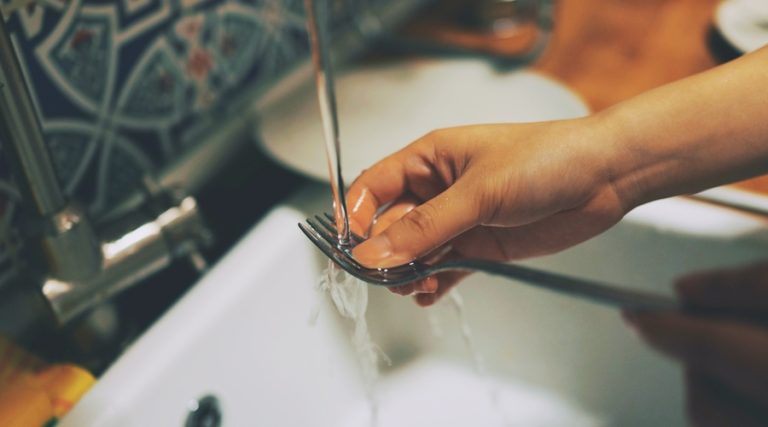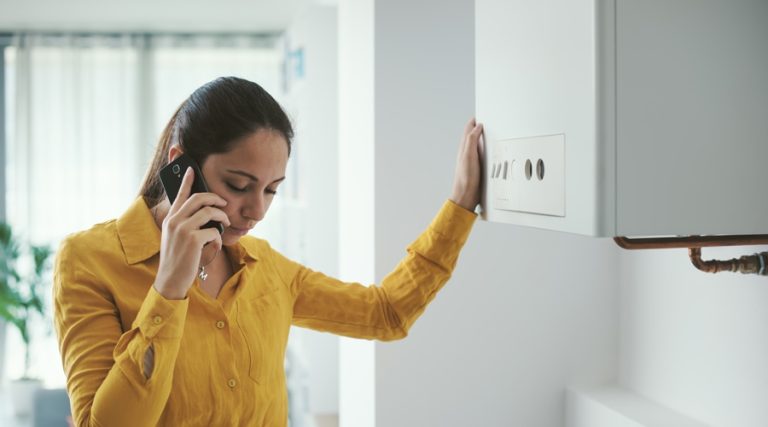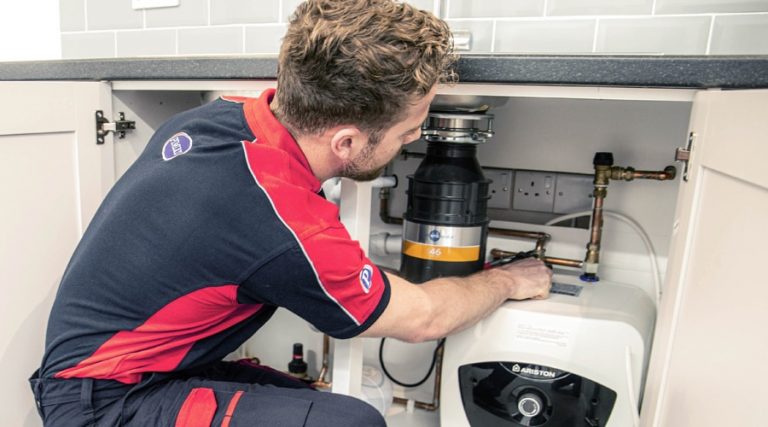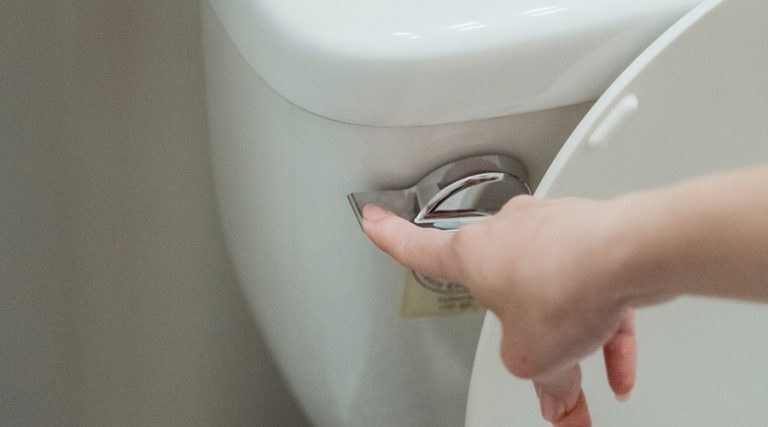How to spot and get rid of 3 types of damp in the home
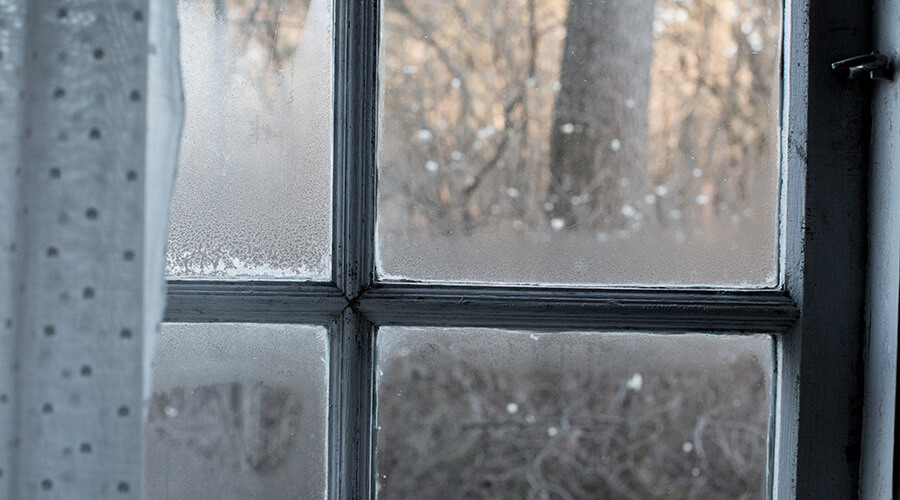
As the cold and wet weather worsens, the chances of finding damp within your home are increased. Spotting damp early gives you a better chance of solving the problem, preventing mould from growing and damaging your home or décor. But how do you spot damp?
Read our handy guide to damp and find out what damp is, how it is caused, and how you can fix and prevent it this winter and throughout the year.
What is damp in the house?
Damp is the presence of excess moisture in a room or rooms of a building. Any building or home can be affected by damp. It is a problem which can be serious, as damp can cause damage to a building’s structure and can even cause health problems if left untreated. But what causes damp?
This excess moisture could be caused by many things, including water leaks and insufficient ventilation, but overall there are three main types of damp to look out for. To help find the solution to any damp problem, you need to first find out the source of the excess moisture and figure out which of the three types of damp detailed below is in your home.
What are the 3 types of damp?
There are three main types of damp:
- Rising damp
- Penetrating damp
- Condensation damp
Most damp issues are usually down to excess water vapour and condensation, making condensation damp the most common type you would typically find in your home. However, all three of these types of damp can be found in buildings and can be more serious. Let’s start with the most common type of damp.
Condensation damp
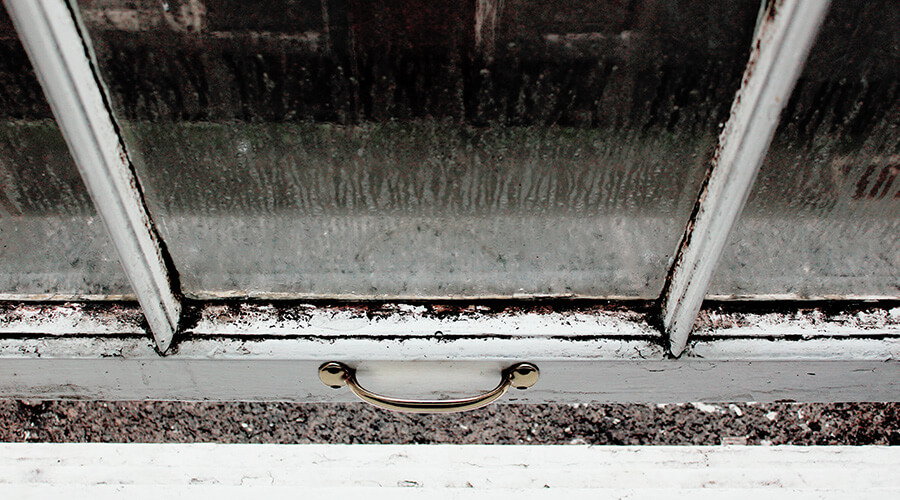
Condensation damp is a common problem. This damp happens when moist air meets a colder surface like walls, windows, mirrors etc. The air can’t hold the moisture and tiny drops of water, or condensation, begin to appear.
Water vapour in the air can be naturally occurring from weather, breathing, and even plants, or more commonly through hot water and steam. Vapour is fairly harmless, its only when it comes into contact with something cold that it can be troublesome.
The best solution for preventing condensation damp is keeping your home and rooms well heated and ventilated. We suggest retaining a constant low setting on your heating to maintain warmth and prevent cold spots from gathering condensation, such as windows and exterior walls that back the cold air outside.
Using proper ventilation, such as extractor fans in bathrooms and toilets, and opening windows can reduce the moisture in the air. You can also use a dehumidifier to help draw out moisture, or air conditioning to reduce the humidity.
If your home is older, you can improve the insulation of your property by fitting double glazed windows and loft or wall insulation.
Penetrating damp
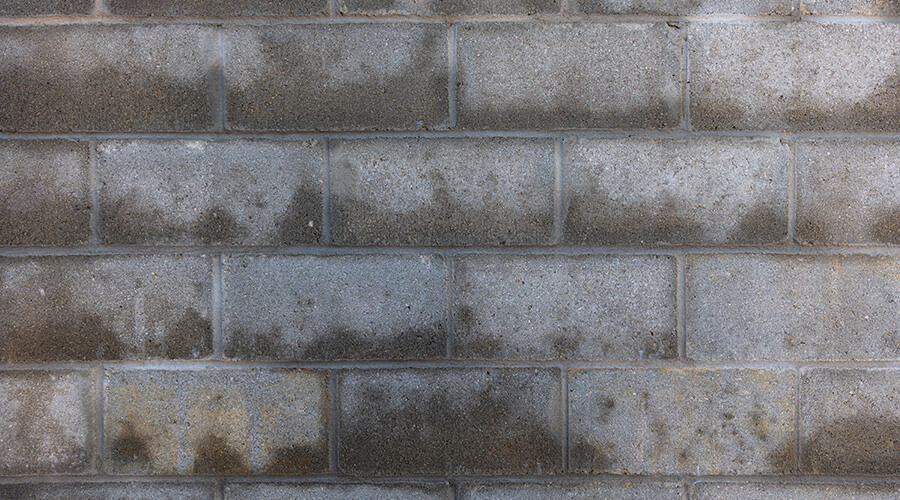
This type of damp is caused by water leaking through the walls. This can happen due to structural issues, including damaged piping, faulty guttering, roofing problems, or cracks in the exterior walls. Some other causes of penetrating damp could be:
- Leaking walls
- Air gaps
- Damaged gutters and piping
- Porous bricks
- Cavity wall problems
- Poor cavity insulation
If you have penetrating damp, you can expect to see a watermark that appears on the wall. Damp patches can continue growing as the water leaks in. It is advisable for a professional to analyse the problem and identify the root cause of the damp to provide an effective solution. If you suspect that your guttering is blocked and causing damp, you can learn about the signs of blocked guttering in our blog.
If you discover that a leaking pipe is causing the damp, or a damaged roof, our emergency plumbers and roofers can help get to the root of the problem and prevent further damage.
Rising damp
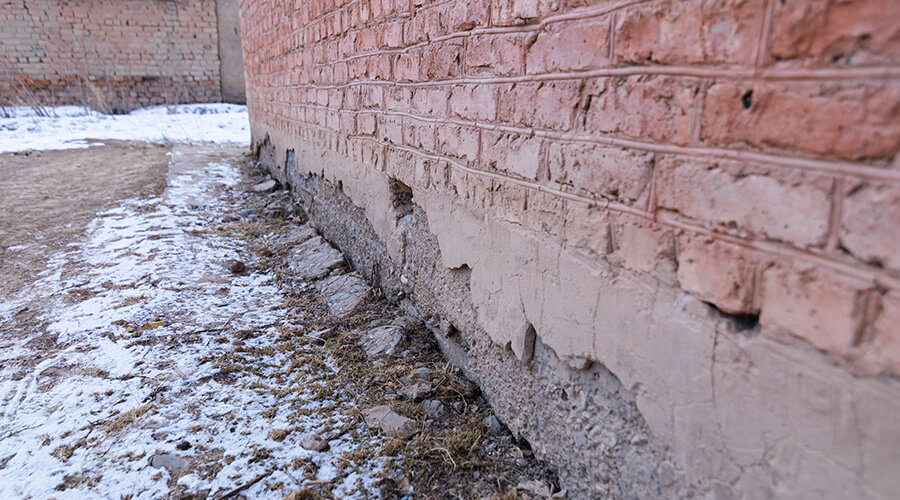
Rising damp is quite a rare type of damp that can affect the walls of buildings. Moisture can travel up from the ground and through the walls by capillary action. This action is defined as the movement of water within the gaps of a porous materials, for example wetting a sponge. Around the affected wall, you can usually find porous building materials, such as plaster, wooden floorboards, skirting, and joists, which can easily absorb water from the ground. Alongside damaged walls, another sign of rising damp may be wet rot in your home’s wooden flooring and skirting.
Rising damp is typically first identified by the harm it does to a building’s interior walls. Wallpaper can become loose and peel, and plaster or paint might deteriorate over time. Inside your home, you might notice a watermark on the walls indicating where the water level inside has gotten to. Externally, the walls may develop white salt streaks, and the mortar may degenerate.
Most homes and buildings have a protective layer made of non-absorbing material to prevent rising damp, though some older properties may not. It is worth checking if a property has this before buying a home.
If your problem isn’t condensation damp or easily identified, it is a good idea to find a professional to help discover the cause and fix it as soon as possible.
Now you know the three types of damp, the next step is removing it and preventing it.
How do you get rid of damp?
If you are wondering ‘how can I stop damp in my house?’ or ‘how to get rid of damp on walls permanently’, then we have some tips on finding the source, removing damp, and how to prevent it from coming back or starting in the first place.
Getting rid of damp in the house is a good start to prevent damage from growing mould and mildew. The first thing to do is locate the problem, and these are the most common areas to check first for signs of damp:
- Walls
- Floors
- Ceilings
- Windows
- Doors
Most damp is caused by condensation. If you aren’t aware of any previous issues with rising damp, or if you have a protective layer in your home, then you can usually rule that type out. If your guttering, piping, and wall cavities are undamaged, regularly checked and maintained, then you are unlikely to have to penetrating damp problems. This would leave condensation damp as the most likely type.
Here are a few quick tips to remember day-to-day, to help prevent condensation damp in your home:
- Use lids on pans when cooking to reduce steam and moisture from boiling water.
- Use extractor fans in the kitchen and bathroom.
- Close kitchen and bathroom doors where possible to prevent steam spreading through the colder areas of the house.
- Dry clothes outdoors to prevent excess moisture from building up. If you can’t leave them outside, leave them in the bathroom with the door closed and windows open until they are dry.
- Ensure your washing machine or tumble dryer is correctly vented.
- Move furniture away from external walls to improve air circulation around the property. With wardrobes, try placing them on internal walls which aren’t as cold as the external ones.
With excess moisture and condensation, you can also experience odd smells alongside other problems. Reducing damp is the first step to a better smelling home, but here are some extra tips on how to get rid of damp smells:
- Use good ventilation
- Clean and dry your appliances
- Clean and dry your rugs and door mats
- Use effective freshener sprays
- Air out your home regularly
If you are experiencing damp in your home, or if you are worried about getting damp in the future, then you can reach out to our experienced team who can help with damp proofing, as well as a wide range of building and plastering services.
What if I find mould?
If any type of damp goes untreated for a length of time, it can cause mould on walls or windows in your home. Since having mould on the walls in your house can cause health problems, it is worth finding the source and removing the mould as quickly and safely as possible. It’s also a good idea to note the problem areas in your home and keep an eye on them, especially during the colder and wetter months.
Mould-related health problems
Removing mould is especially important if you, or people you know, are susceptible to mould or its spores. People with allergies may be more sensitive to mould, and those with immune suppression or underlying lung disease are more susceptible to fungal infections. Anyone with breathing conditions such as asthma or COPD (Chronic Obstructive Pulmonary Disease) also has an increased risk for infection from moulds.
If you or your family members have any of these conditions, a qualified medical clinician should be consulted for diagnosis and treatment, and the affected person/s should avoid cleaning away mould without adequate protection such as masks and gloves. Limiting or entirely removing exposure to mould is the best option to avoid mould-related health problems.
Getting rid of mould
Removal of damp-induced mould can be tricky and if not done correctly, as some mould can remain and grow back. To solve this, we recommend removing the mould first as best as you can using the tips below before addressing the damp problem next. Mould can be a recurring problem in particularly tricky areas to keep dry, such as bathrooms or kitchens. If there is another reason for the damp and mould in your home apart from condensation, such as a leak, it is worth removing the mould in the meantime, before getting a professional to locate and fix the problem.
It is important to properly clean and dry the affected area/s as people can still have an allergic reaction to parts of the dead mould, and mould contamination may reoccur if there is still a source of moisture.
Mouldy hard surfaces
Thoroughly clean all affected hard surfaces including flooring, molding, metal furniture, countertops, and sinks with commercial products, water and dish detergent or a bleach solution. Scrub cleanable surfaces, such as wood, tile, or stone with soapy water and a bristle brush. Dry surfaces quickly and thoroughly after cleaning.
WARNING: Never mix bleach with ammonia or other household cleaners. Doing this will create dangerous and toxic fumes.
If you do choose to use bleach to clean up mould, follow these safety tips during preparation and cleaning:
- Use 1 part of bleach to 10 parts of water in your solution
- Open windows and doors to provide fresh air
- Wear non-porous gloves and protective eye wear
- Wear a mask to prevent fume inhalation
- Protect your clothing or wear old clothes
- Secure bleach away from young children and pets
- Don’t wipe away the solution unless the area is for food preparation or within reach of children
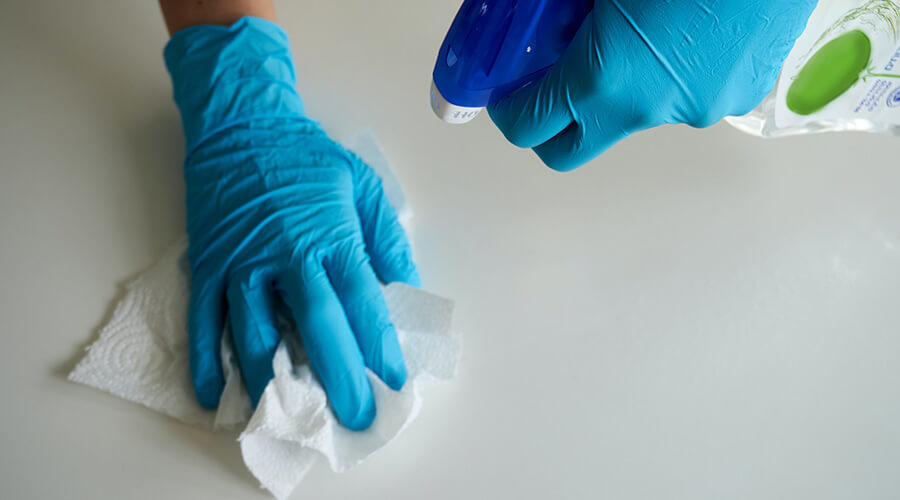
Mouldy items and absorbent materials
If any items, including toys and anything that can’t be thoroughly cleaned, get mouldy from damp in your home, you should remove them from the living areas and dispose of them if necessary. Once mould starts to grow in absorbable materials such as carpet, insulation or ceiling tiles, unfortunately the only way to deal with the problem entirely is by removing and replacing the materials completely.
Mould and damp after flooding
With winter weather causing more rainfall, floods can happen and cause a huge issue with damp, even after the flood water subsides.
If this should happen, it is advisable to clean up and dry out your home thoroughly and quickly, within 24-48 hours after any flooding. Dig out as much mud and dirt as possible and use a wet vacuum to remove remaining dirt. If you have a fan, air conditioner or dehumidifier that wasn’t affected by flooding, you can use it to help the surfaces dry after you finish cleaning up. Also remove or replace any carpets and upholstery that have been soaked and cannot be dried promptly to prevent mould growth.
Preventing mould caused by damp
If you find yourself saying ‘how do I get rid of damp forever?’, then you are not alone. The best way to ensure you permanently get rid of your damp-related mould problems is to prevent the build-up of moisture in your home by properly ventilating it at all times. Some people advise purchasing a dehumidifier, however these units do require regular emptying, cleaning and often increase energy bills.
Most mould problems that do slip through are usually small and can be cleaned away easily, but mould can still grow in problem areas, like bathrooms and kitchens, where prevention is the best solution.
Regular house maintenance and inspections are a good idea to check for early signs of leaks and problems that could cause troublesome damp further down the line. See our ultimate winter checklist to help check and get your property bulletproof and ready for the winter.
Controlling humidity levels can help reduce damp and mould growth. An air conditioner or dehumidifier will help you keep the level low, though bear in mind that humidity levels can change over the course of a day with changes in the moisture in the air and the temperature, so you will need to check the humidity levels more than once a day for this to be effective.
Thoroughly cleaning and drying areas of your home after discovering damp, or after flooding, can ensure the damp doesn’t progress and encourage mould. You can also use mould-resistant or anti-mould paint after cleaning away mould, to help kill off the last of the spores and prevent regrowth.
Conclusion
If you have a recurrent problem with damp or an extensive amount of mould, and you do not think you can manage the cleanup on your own, then you may want to contact a professional who has experience in cleaning mould in buildings and homes.
Our building experts can offer damp proofing in your home amongst many other services to help you get your home back to its former glory, and our plumbers can help fix leaking pipes or other potential sources of damp.
At Pimlico, we provide 24/7 services, even out of hours. If you need us in an emergency, we have no call-out fees and we aim to get to you within an hour. Contact us today and we can help answer any of your questions.


